|
|
|
|
 News Highlights News Highlights
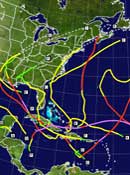 2011 Atlantic Hurricane Season Forecast 2011 Atlantic Hurricane Season Forecast
Scientists at COAPS have just released their third annual Atlantic hurricane season forecast. This year's forecast calls for a 70 percent probability of 14 to 20 named storms and 8 to 10 hurricanes. The mean forecast is for 17 named storms, 9 hurricanes, and an accumulated cyclone energy (ACE; a measure of the strength and duration of storms) of 163. These numbers are above the 1995-2010 average of 14 named storms and 8 hurricanes, and are related to warm tropical North Atlantic sea surface temperatures, a weakening of La Niņa conditions, and the ongoing positive phase of the Atlantic Multi-decadal Oscillation.
Tim LaRow and his colleagues use a numerical climate model developed at COAPS to understand seasonal predictability of hurricane activity. The model is one of only a handful of numerical models in the world being used to study seasonal hurricane activity and is vastly different from the statistical methods used by other hurricane forecasters. The COAPS model uses high performance computers to synthesize massive amounts of information, including atmospheric, ocean, and land data.
The COAPS forecast is already gaining recognition for its accuracy only two years after its launch. The 2009 forecast predicted 8 named storms and 4 hurricanes, and there ended up being 9 named storms and 3 hurricanes that year. The 2010 forecast predicted 17 named storms and 10 hurricanes, and there were actually 19 named storms and 12 hurricanes.

Now Airing: New WFSU Environmental Minute Radio Program Be sure to tune in to the Environmental Minute, a new radio program featuring environmental experts from FSU and led by COAPS scientist Vasu Misra! The program airs Mondays and Wednesdays at 10:04am on 88.9 WFSU-FM.
The following is a list of previously aired segments now archived at http://wfsu.org/environmental and on the Environmental Minute Facebook page:
- James O'Brien (5/2 & 5/4): Why don't hurricanes form over land, and why do they tend to die when they make landfall?
- Jeff Chanton (5/9 & 5/11): Performance based septic systems have been required for new contruction in Wakulla County and have been suggested for southern Leon County. What are these systems, and do they really reduce nitrogen levels in our groundwater?
- Allan Clarke (5/16 & 5/18): What is El Niņo, and how does it affect the Big Bend region?
- Greg Boebinger (5/23 & 5/25): Can high magnetic fields affect the weather?
- Vasu Misra (5/30 & 6/1): What does a forecast of 20% chance of rain mean?
- Mark Bourassa (6/6 & 6/8): What can we learn about Earth's climate from space?
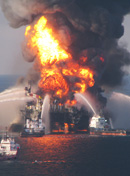
$233,000 for Oil Spill Research COAPS has been awarded two research grants totaling $233,000 from BP through the Northern Gulf Institute to conduct research relating to the 2010 BP oil spill in the Gulf of Mexico. $168,000 is being used by Eric Chassignet, Steve Morey, and Dmitry Dukhovskoy to develop an advanced earth modeling system to better understand the effects of the oil spill on the Northern Gulf of Mexico ecosystem. $65,000 is being used by Mark Bourassa, Morey, and Dukhovskoy to develop techniques for mapping the location and movement of surface oil slicks using satellite scatterometer instruments and computer models.

Alumnus David Legler New Director of NOAA Climate Observations Division
David Legler, who received his PhD and MS in meteorology under the guidance of COAPS professor James O'Brien, is the new director of the Climate Observation Division at the National Oceanic and Atmospheric Administration (NOAA) Climate Program Office. Legler previously served as director of the US Climate Variability and Predictability Research Program.
 Mark Powell Briefs the Florida Energy and Climate Commission on Wind Energy Resources in Florida Mark Powell, a NOAA scientist stationed at COAPS, recently briefed the Florida Energy & Climate Commission on wind power viability for Florida. Powell presented research he has conducted at COAPS with Shawn Smith and Cristina Collier on the potential for using offshore wind energy to help power Florida. The Commission manages the state's energy-related grant funds (including over $175M in stimulus funds), and helps develop state energy and climate change policies and programs.  
COAPS Meteorology Undergraduates Presenting Research at Major Climate Conference Congratulations to COAPS undergraduates Dan Gilford and Rochelle Worsnop, who will be traveling to Asheville, NC, in July to present research posters at the American Meteorological Society's 19th Conference on Applied Climatology! Rochelle's poster is titled "Multi-decadal view of temperature extremes across the southeastern United States," and Daniel's is titled "Southeastern US daily temperature ranges and predictability with El Niņo Southern Oscillation." Seed Money Available for Interdisciplinary Collaborations between UF and FSUlimate Conference The Florida Climate Institute will be offering a limited number of seed grants to FSU faculty (research or tenure-track) to develop collaborative UF-FSU research proposals to national agencies. More information is available here (PDF). The application deadline is July 31, 2011. |
 COAPS in the Press COAPS in the Press
Feb.-Mar./2011: Alumna uses science to give Navy advantage (Florida State Times, p.3; with COAPS alumna Ruth Preller and COAPS scientist James O'Brien)
3/11/11: How does a tsunami start? (WCTV; with COAPS scientist Steve Morey)
4/1/11: Storm brings mix of damage and benefits (Daytona Beach News-Journal; with COAPS scientist David Zierden)
5/24/11: Rainy season unlikely to return anytime soon (Daytona Beach News-Journal; with COAPS scientist David Zierden)
5/24/11: Fla. building codes key in limiting tornado damage (Ocala Star-Banner; with COAPS scientist James O'Brien)
5/26/11: Florida's climate is a deterrent to killer tornadoes, but state ranks third in the number of storms (Palm Beach Post; with COAPS scientist James O'Brien)
6/1/11: Florida State keeps an eye on hurricane season (FSU Headlines Radio; with COAPS scientist Tim LaRow)
6/5/11: Recipe for a perfect storm: La Niņa - just what is it? (Citrus County Chronicle; with COAPS scientist James O'Brien) |
 Recent Publications Recent Publications
COAPS authors are in bold.
Hanson, H.P., Bozec, A., and A. Smentek-Duerr, 2011: The Florida Current: A clean but challenging energy resource. EOS Trans. AGU, 92, 29-30, doi:10.1029/2011EO040001.
Krishnamurthy, V., and V. Misra, 2010: Daily atmospheric variability in the South American monsoon system. Climate Dynam., doi:10.1007/s00382-010-0881-4. (in press)
Liu, J., J. A. Curry, C. A. Clayson, and M. A. Bourassa, 2011: High-resolution satellite surface latent heat fluxes in North Atlantic hurricanes. Mon. Weather Rev., doi:10.1175/2011MWR3548.1. (in press)
May, J., and M. A. Bourassa, 2011: Quantifying variance due to temporal and spatial difference between ship and satellite winds. J. Geophys. Res. - Oceans, doi:10.1029/2010JC006931. (in press)
Misra, V., L. Moeller, L. Stefanova, S. Chan, J. O'Brien, T. Smith III, and N. Plant, 2011: The influence of the Atlantic Warm Pool on Panhandle Florida Sea Breeze. J. Geophys. Res. - Atmospheres, doi:10.1029/2010JD015367. (in press)
Nof, D., Y. Jia, E.P. Chassignet, and A. Bozec, 2011: Fast wind-induced migration of Leddies in the South China Sea. J. Phys. Oceanogr., doi:10.1175/2011JPO4530.1. (in press)
Ren, L., K. Speer, and E. P. Chassignet, 2011: The mixed layer salinity budget and sea ice in the Southern Ocean. J. Geophys. Res. (accepted)
|
 Photos Photos
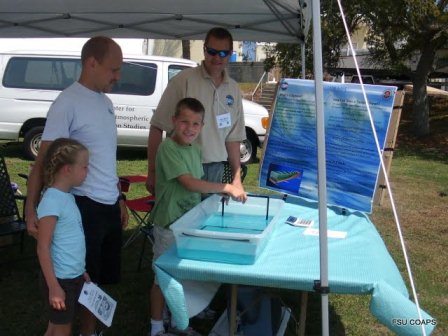
| |
COAPS scientists Dmitry Dukhovskoy (left) and Steve Morey give a tsunami demonstration at the FSU Coastal & Marine Laboratory Open House (4/16/2011). |
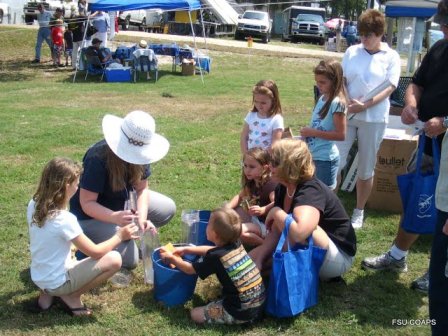 COAPS scientist Melissa Griffin teaches children how to use rain gauges to measure precipitation at the FSU Coastal & Marine Laboratory Open House (4/16/2011).
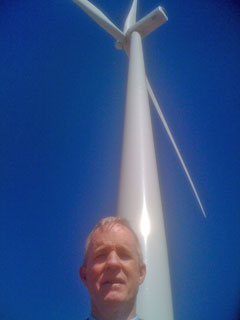
Mark Powell, a NOAA scientist stationed at COAPS, visited Texas Tech University in April to share information about his research on hurricane winds. Powell is working with scientists at FSU to develop a new wind turbine, which is undergoing testing at Texas Tech. |
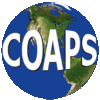  About COAPS About COAPS
The Florida State University Center for Ocean-Atmospheric Prediction Studies (COAPS) is a center of excellence performing interdisciplinary research in ocean-atmosphere-land-ice interactions to increase our understanding of the physical, social, and economic consequences of climate variability.
COAPS scientists and students come from a wide range of disciplines, including meteorology, physical oceanography, statistics, and the computer and information sciences.
|
|
|